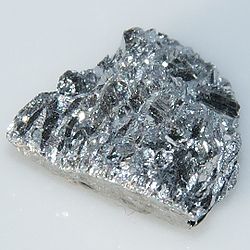Antimony: (Sb)
Melting
Point:
1167
Fahrenheit
\ 631
CelsiusBoiling Point: 2889 Fahrenheit \ 1587 Celsius

A lustrous grey metalloid, it is found in nature mainly as the sulfide mineral stibnite (Sb2S3). Antimony compounds have been known since ancient times and were used for cosmetics, metallic antimony was also known but mostly identified as lead.
Antimony compounds are prominent additives for chlorine and bromine containing fire retardants found in many commercial and domestic products. The largest application for metallic antimony is as alloying material for lead and tin. It improves the properties of the alloys which are used as in solders, bullets and ball bearings. An emerging application is the use of antimony in microelectronics.
Alloys Antimony forms a highly useful alloy with lead, increasing its hardness and mechanical strength. For most of the application where lead is used varying amounts of antimony are use as alloying metal. The Sb–Pb alloy is used in lead–acid batteries. It is used in antifriction alloys, such as Babbitt metal. It is used as an alloy in bullets and lead shot, cable sheathing, type metal (e.g. for linotype printing machines, solder – some "lead-free" solders contain 5% Sb, in pewter, and in hardening alloys with low tin content in the manufacturing of organ pipes.
Antimony is a silvery, lustrous gray metal that has a Mohs scale hardness of 3. Therefore, antimony by itself is not used to make hard objects: coins made of antimony were issued in China's Guizhou province in 1931, but because of their rapid wear their minting was discontinued. Antimony is resistant to attack by acids.
The largest application world wide for antimony is the use as flame retardants with 60% while the use in alloys for batteries, bearings and solders accounts for 20% of the produced antimony. In tiny amounts, antimony is increasingly being used in the semiconductor industry as a dopant for ultra-high conductivity n-type silicon wafers in the production of diodes, infrared detectors, and Hall-effect devices. Other applications include use is in polymers, additive in some glasses as fining agents, aiding in the removal of microscopic bubbles and a large application is for the use as pigment.
Precautions
Antimony and many of its compounds are toxic, and the effects of antimony poisoning are similar to arsenic poisoning. The toxicity of antimony is by far lower than that of arsenic, this might be caused by the significant differences of uptake, metabolism and excretion between arsenic and antimony. The uptake of antimony(III) or antimony(VI) in the gastrointestinal tract is at most 20%. Antimony(VI) is not quantitative reduced to antimony(III) in the cell. Methylation of antimony does not occur and therefore the excretion of antimony(VI) in the urine is the main way of elimination. Reported cases of intoxication by antimony equivalent to 90 mg antimony potassium tartrate dissolved from enamel showed only short term effects. An intoxication with 6 g of antimony potassium tartrate was deadly after 3 days. Inhalation of antimony dust is harmful and in certain cases may be fatal; in small doses, antimony causes headaches, dizziness, and depression. Larger doses such as prolonged skin contact may cause dermatitis; otherwise it can damage the kidneys and the liver, causing violent and frequent vomiting, and will lead to death in a few days.
The abundance of antimony in the Earth's crust is estimated at 0.2 to 0.5 parts per million, comparable to thallium at 0.5 parts per million and silver at 0.07 ppm. Even though this element is not abundant, it is found in over 100 mineral species. Antimony is sometimes found native, but more frequently it is found in the sulfide stibnite (Sb2S3) which is the predominant ore mineral. Commercial forms of antimony are generally ingots, broken pieces, granules, and cast cake. Other forms are powder, shot, and single crystals. The People's Republic of China was the top producer of antimony with about 84% world share followed at a distance by South Africa, Bolivia and Tajikistan.

Antimony ingots are currently selling in the 15.00 - 23.00 dollar range per pound.
TheFoundryZone.com